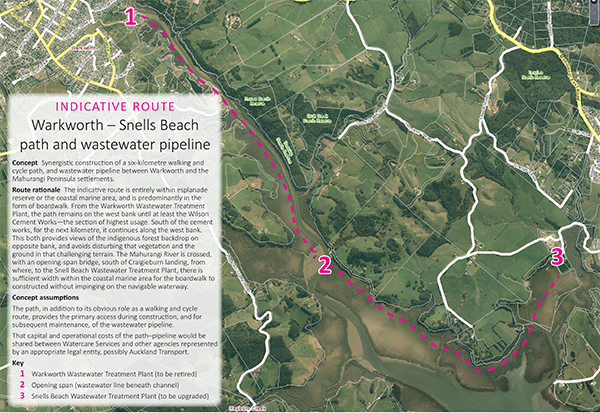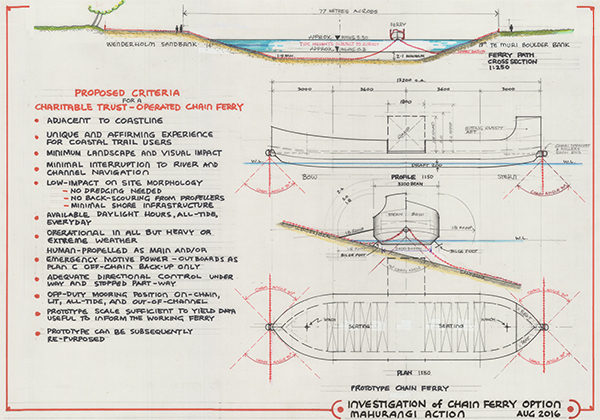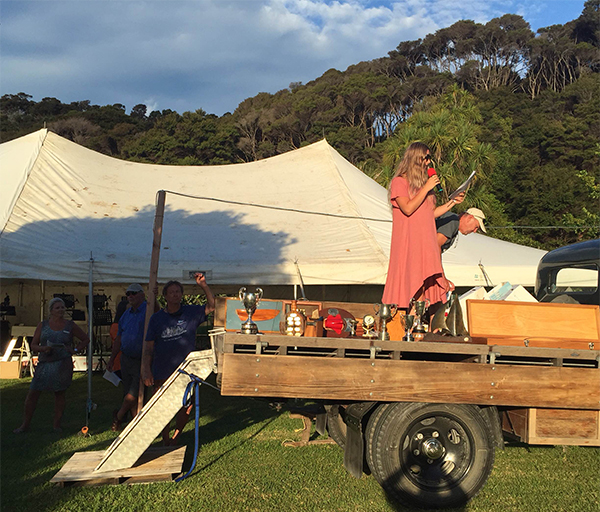Mahurangi Action 2015–2016 annual report
Since it was formed 42 years ago, Mahurangi Action has had some big wins.
But not only has the 2015–2016 term of office seen the greatest number of wins in a single year, one of those wins was 42 years in the making: The decision by Watercare Services to cease the discharge of wastewater into the Mahurangi River. The icing on the cake could be combining of the new wastewater pipeline from Warkworth to Snells Beach with a walkway, but, to date, Watercare Services is sceptical, but, at Mahurangi Action’s urging, is doing a desktop study of the potential symbiosis of the concept. Either way, the goal of restoring the Mahurangi River as a swimmable river, including at the town basin, is now that much more realistic.
Possibly eclipsing this achievement, was convincing Auckland Council of Mahurangi Action’s 29-year-old vision for keeping Te Muri car-free forever. When the first threat to Te Muri’s sense of splendid isolation was seen off three decades ago—when a road-bridge was to have been built across its estuary, to provide parking for thousands of cars—there was a lingering concern that the cause of a car-free Te Muri would have to be relitigated at some point in the future. This is exactly what occurred in 2010, when the 383-hectare Schischka farm became the last-gasp purchase regional parkland purchase of the Auckland Regional Council, as it was in the throes of being subsumed by the new Auckland Council unitary authority. Auckland Council was convinced that the $15 million purchase could only be justified by using the farm as vehicle access for visitors:

Icing Longshot: While the siloed priorities of council-controlled organisations works against the concept of symbiosis, there is no doubt a level path between Snells Beach and Warkworth, which doubled as wastewater pipeline, would be infrastructure of regional renown, and doubling satisfying knowing that the wastewater that once ran in the river was now sanitarily piped, and the river, potentially, swimmable route and notation Mahurangi Action
For Auckland Council officers to subsequently recant that position and actively recommend the car-free development of Te Muri is a remarkable achievement for the community, and highly commendable example of responsiveness by the council.
Part of the original strategy for a car-free Te Muri, back in 1987, was for a Mahurangi Coastal Trail connecting Mahurangi West, Te Muri, and Wenderholm. The most challenging aspect of the proposal was always going to be crossing the Pūhoi Estuary. Mahurangi Action, over the last five years, thoroughly explored footbridge options, only to have that option rejected on grounds of cost and landscape and visual impact. But here is where Auckland Council officers again stepped up to the mark, by suggesting a chain ferry, which:
could become a unique attraction in itself, without the need for large infrastructure crossing the river.

Satisfying Litany of Criteria: All-tide, unobtrusive, sustainable, and achievable. Short of diverting the Mahurangi Coastal Trail upstream three kilometres and building a footbridge nearly as long as the one Auckland Council estimated might cost $10–20 million. If that was not bad enough, the four-kilometre return walk to the coast at Te Muri would be through difficult terrain, and far from family-friendly, round trip. rendering Jefferson Chapple
This is undoubtedly true, and a depiction of the chain ferry, commissioned by Mahurangi Action, has brought the project to the attention of a highly respected trans-Tasman environmental consultancy. This means that, sooner than otherwise could have been contemplated, a detailed and costed project plan for the coastal trail will be ready to put up for funding, as part of the coordinated network of paths and trails overseen by the new Rodney East paths and trails trust, which Mahurangi Action helped to establish.
But while Te Muri has a huge and relieved following, it is the Mahurangi Regatta, which Mahurangi Action revived in 1977, that is better known—as a significant regional event, nicely bookending the Auckland Anniversary Regatta. And the 2016 event saw the biggest leap forward for the event since Mahurangi Action, and particularly members Pete Bailey and Peter Oxborough, instigated the Mahurangi Cup for classic wooden boats of pre-1955 design, save perhaps for the revival of the prize-giving dance, in 2004. This was the support, and long-term commitment of a significant sponsor: Teak Construction, whose managing director, Stuart Charlton, is a Mahurangi West resident. Not only has this obviated the need to perennially cut corners, it has allowed Mahurangi Action to make better use of the event to promote Mahurangi causes. An example is the purchase of a custom-designed entries tent that also promotes the Mahurangi Coastal Trail.

Shot-in-the-Arm Personified: Mahurangi Action president Tessa Berger presiding over the 2016 prize giving, personified the shot in the arm that the Mahurangi Regatta has received by attracting a substantial, long-term sponsor. image Sarah Ransom
Those who attended the Mahurangi Regatta Prize-Giving Dance, as well as enjoying a genuinely unique event and tradition, were treated to a taste of the future, with Tessa Berger co-hosting, with Mahurangi Cruising Club commodore Stephen Horsley, the prize giving.
A win for, rather than by, Mahurangi Action, is the new Mahurangi Magazine, which acts as the organisation’s voice piece. Like many friends of the Mahurangi, the website architect, builder and webmaster, Tira Cole, has not continuously been a financial member, although she was in 2001 when all hands were needed on deck to prevent a rogue chairman from scuttling the publication of Jade River: A History of the Mahurangi. The shipshape, smartphone-friendly website Tira has created, which will cause folk to assess the cut of Mahurangi Action’s jib far more favourably, has largely been an in-kind contribution. The Mahurangi has good friends indeed.
Finally, Mahurangi Action president Tessa Berger’s brilliantly successful first foray into politics is another win for, rather than by, the 42-year-old organisation. On the Rodney Local Board, Tessa is already championing the need for an inspired structure plan for Warkworth, to ensure that the five-fold growth planned does justice to the town’s potential and the Mahurangi River’s mana and beauty.

